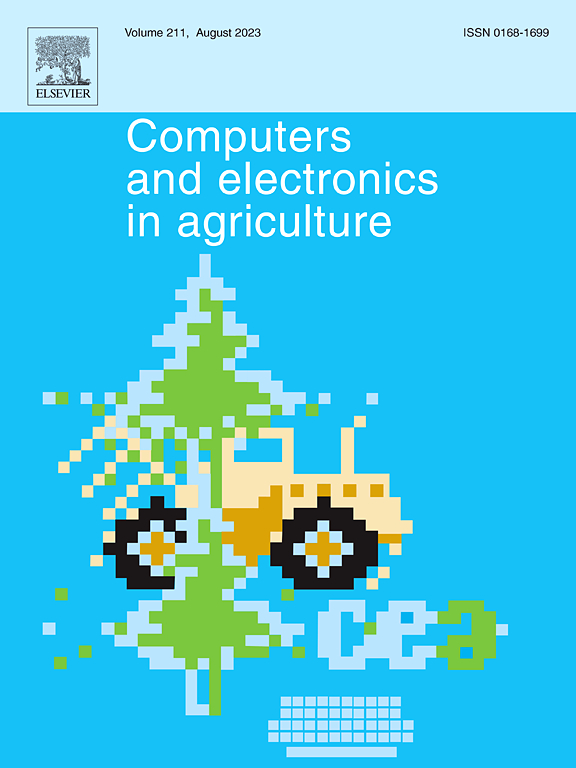Detection of a vascular wilt disease in potato (‘Blackleg’) based on UAV hyperspectral imagery: Can structural features from LiDAR or SfM improve plant-wise classification accuracy?
IF 7.7
1区 农林科学
Q1 AGRICULTURE, MULTIDISCIPLINARY
引用次数: 0
Abstract
Ensuring plant health is a key factor to maximize crop yield. Despite that, the current field scouting and disease monitoring approaches often rely on visual evaluations and are, therefore, subjective and time demanding. New methods to assist in disease detection and severity assessment are required to allow better crop management and higher throughput in field phenotyping studies. With this objective, techniques involving the use of multi- and hyperspectral imagery for retrieval of plant traits and assessment of general crop health status are increasingly being proposed as alternatives to conventional disease monitoring approaches. Conversely, research focusing on specific pathogens are still lacking in many cases, in particular studies investigating multi-source sensing approaches, which have the potential to improve retrieval/classification accuracy. In this study, hyperspectral imagery and point clouds obtained with LiDAR or through Structure from Motion algorithm (SfM) applied to high resolution RGB images were evaluated as possible alternatives to detect Blackleg (caused by bacteria of the genera Pectobacterium and Dickeya) in potato. It was demonstrated that all the different datasets have potential to discriminate healthy from diseased plants. The combination of Vegetation Indices (VIs) derived from hyperspectral images with structural features from LiDAR resulted in the best validation results (Balanced Accuracy – BA = 0.915). Small improvements were also achieved by combining VIs with SfM features (BA = 0.876) in comparison to VIs alone (BA = 0.846). Evaluation of feature importance for classification models derived from the different datasets indicated that after structural features derived from LiDAR or RGB imagery were added as predictor variables the relative importance of VIs for the predictions decreased, in particular for VIs related to LAI or other traits describing canopy properties. Finally, analysis of false negatives and positives indicated some limitations to the predictive potential of the different datasets, with diseased and healthy plants eventually presenting atypical structural and spectral characteristics in comparison to those expected for their classes. Therefore, multi-source sensing, including additional modalities (e.g., thermal or fluorescence), might be required to further improve detection of pathogens with complex symptoms, as those affecting roots, tubers and stems.
基于无人机高光谱图像检测马铃薯维管束枯萎病("黑腿病"):激光雷达或 SfM 的结构特征能否提高植物分类的准确性?
确保植物健康是作物产量最大化的关键因素。尽管如此,目前的田间侦察和病害监测方法往往依赖于目测评估,因此主观性强,耗时长。需要新的方法来协助病害检测和严重程度评估,以便更好地管理作物,提高田间表型研究的产量。为了实现这一目标,越来越多的人提出使用多光谱和高光谱图像检索植物性状和评估作物总体健康状况的技术,以替代传统的病害监测方法。相反,在许多情况下仍然缺乏针对特定病原体的研究,特别是缺乏调查多源传感方法的研究,而这种方法有可能提高检索/分类的准确性。在这项研究中,对使用激光雷达或通过应用于高分辨率 RGB 图像的运动结构算法(SfM)获得的高光谱图像和点云进行了评估,将其作为检测马铃薯黑腿病(由果胶杆菌属和Dickeya属细菌引起)的可能替代方法。结果表明,所有不同的数据集都具有区分健康植物和病害植物的潜力。将从高光谱图像中提取的植被指数(VIs)与激光雷达的结构特征相结合,可获得最佳验证结果(平衡精度 - BA = 0.915)。将 VIs 与 SfM 特征相结合(BA = 0.876)与单独使用 VIs(BA = 0.846)相比,也取得了微小的改进。对来自不同数据集的分类模型的特征重要性评估表明,在将来自激光雷达或 RGB 图像的结构特征添加为预测变量后,VIs 对预测的相对重要性降低了,特别是与 LAI 或其他描述冠层特性的特征相关的 VIs。最后,假阴性和假阳性分析表明,不同数据集的预测潜力存在一些局限性,病虫害植物和健康植物最终会呈现出非典型的结构和光谱特征,而这些特征与其类别的预期特征不同。因此,可能需要多源传感,包括其他模式(如热或荧光),以进一步改进对症状复杂的病原体的检测,如影响根、块茎和茎的病原体。
本文章由计算机程序翻译,如有差异,请以英文原文为准。
求助全文
约1分钟内获得全文
求助全文
来源期刊

Computers and Electronics in Agriculture
工程技术-计算机:跨学科应用
CiteScore
15.30
自引率
14.50%
发文量
800
审稿时长
62 days
期刊介绍:
Computers and Electronics in Agriculture provides international coverage of advancements in computer hardware, software, electronic instrumentation, and control systems applied to agricultural challenges. Encompassing agronomy, horticulture, forestry, aquaculture, and animal farming, the journal publishes original papers, reviews, and applications notes. It explores the use of computers and electronics in plant or animal agricultural production, covering topics like agricultural soils, water, pests, controlled environments, and waste. The scope extends to on-farm post-harvest operations and relevant technologies, including artificial intelligence, sensors, machine vision, robotics, networking, and simulation modeling. Its companion journal, Smart Agricultural Technology, continues the focus on smart applications in production agriculture.
 求助内容:
求助内容: 应助结果提醒方式:
应助结果提醒方式:


